Japan
Wood Products Prices
Dollar Exchange Rates of 10th
Jun
2021
Japan Yen 109.68
Reports From Japan
New strategy - focus on
economic security
The government is set to approve a new growth
strategy and the domestic media anticipate the focus will
be on economic security reflecting the rising tension
between the United States and China. During a press
briefing on the strategy a government spokesperson is
quoted as saying ¡°I doubt there were growth strategies in
the past that played up economic security as a pillar like
this one does.¡±
Masaya Sasaki, Senior Economist at the Nomura Research
Institute commented that under the current situation it will
be difficult to promote free trade and the transfer of data
so Japan will shift direction.
The Japan Times reports that in the new growth
strategy
document the chapter on economic security says that
Japan:
aims to secure technological advantages by
analysing, identifying, fostering and protecting
technologies in which the country has a
competitive edge
will focus on reducing risks of supply chain
disruptions for vital products such as
semiconductors, medical items, batteries and rare
earths
pledges to prop up the competitiveness of the
chip industry
seeks to attract cutting-edge production bases to
the country
plans to build more domestic data centres to store
sensitive data within the country
The draft of the growth strategy states that the changing
international environment has prompted other nations to
make ¡°unprecedented levels of investment to secure
production bases that are vital in terms of economic
security within their home countries.¡±
The changing economic direction will require the private
sector to face issues of economic security that it
unaccustomed to. Companies will need to have tighter
control of supply chains and on raw material sourcing
which could push up costs.
See:
https://www.japantimes.co.jp/news/2021/06/10/business/economy-business/suga-economic-security/
and
https://www.cas.go.jp/jp/seisaku/seicho/seichosenryakukaigi/dai11/siryou1-1.pdf
OECD cuts growth forecast
The Organisation for Economic Co-operation and
Development (OECD) has upgraded its forecast for global
economic growth this year but cut its projection for Japan.
Japan's growth estimate for 2021 as downgraded to 2.6%
from the previous estimate of 2.7% due to the introduction
of strict virus control measures and the slow progress in
Japan's vaccination campaign compared with other OECD
countries.
Third virus emergency holding down recovery
prospects
The Cabinet Office has said its latest survey shows
sentiment among large Japanese companies in the April-
June period became more pessimistic for the second
straight quarter. The confidence index, which surveys
firms capitalised at yen1 billion or more declined to minus
4.7 from minus 4.5 in the January-March period, the
second consecutive negative quarter.
The index for manufacturers turned negative for the first
time in four quarters. The index for non-manufacturers
remained negative although it improved slightly.
The report says the third virus emergency and lockdown is
having a damaging impact on the non-manufacturing
sector.
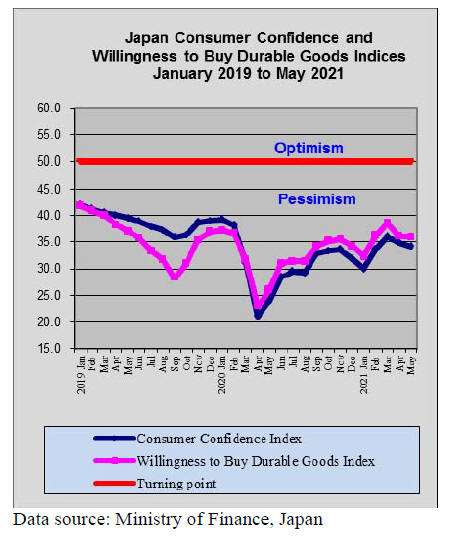
No shift in yen/dollar exchange rate
anticipated
The yen dipped slightly mid-month to below yen 109 to
the US dollar but there is unlikely to be any major shift in
exchange ratesin the short term.
The short lived strengthening of the US dollar was
triggered by a faster than expected increase in the US
consumer price index. Analysts do not foresee any major
strengthening of the dollar against the yen under the
current interest rate regime in the US.
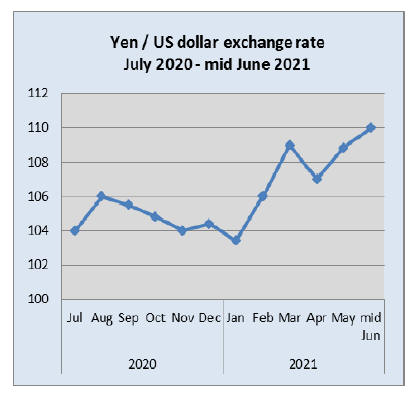
Local governments offering (almost) free
homes
Japan's Housing and Land Survey which is conducted
every five years found there are more than 8 million empty
homes in rural Japan. Now local governments with a stock
of empty homes are making it easy for anyone willing to
come and renovate by selling them for as little as yen
50,000.
Some local authorities have what are called "akiya
bank"
websites listing abandoned homes. The central
government is offering financial incentives and renovation
subsidies.
See:
https://www.insider.com/japanese-government-selling-ruralhomes-cheap-akiya-banks-2021-5

Import update
Wooden door Imports
In April 2021 manufacturers in China, the Philippines and
Indonesia provided most (92%) of Japan¡¯s wooden door
imports. Shippers in China accounted for 62% of April
door imports, the same proportion as in March. Most of
the balance was shipped from Europe and the US.
Year on year, April 2021 imports were 10% higher but
compared to the value of March imports there was a slight
decline in April.

Wooden window imports
The value of Japan¡¯s wooden window (HS441810)
imports in April 2021 were some 15% higher than in
March but year on year there was a decline of around
12%.
Three shippers, China (50%), the Philippines (14%) and
the US (12%) accounted for most of Japan¡¯s wooden
window imports in March 2021. Shipments from the US
fell by half in April compared to a month earlier.
Most of the balance not provided by the top three shippers
came from the EU (17%) with Germany contributing 9%
to Japan¡¯s overall wooden window imports.
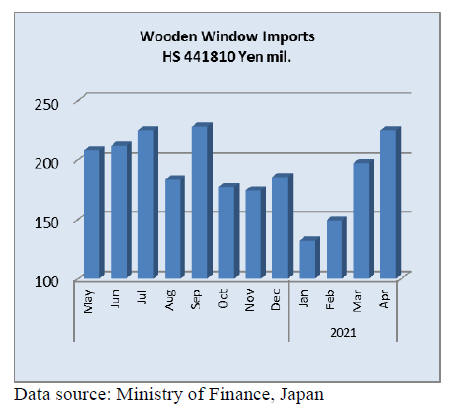
Assembled wooden flooring imports
As in previous months around 60% of flooring shipments
were of HS441875 with most coming from China and
Malaysia. The second largest category of wooden flooring
was HS441879 which accounted for just over 30% of all
wooden flooring imports. In this case, Indonesia and the
US were the main suppliers.
Year on year the value of Japan¡¯s imports of assembled
wooden flooring (HS441871-79) in April fell 20% adding
to the 7% drop in March. Month on month assembled
flooring imports in April were largely unchanged from
March figures.
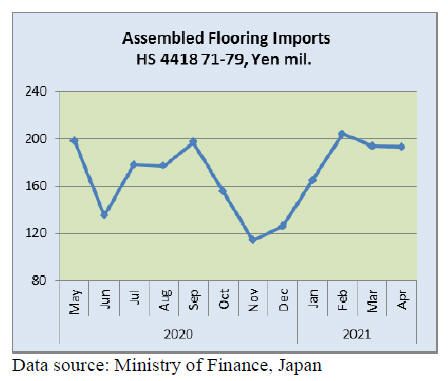
The Long term trend in assembled flooring imports is
illustrated below. In early 2020 there was a sharp
downturn as the seriousness of the corona virus infection
became clear.
The recovery in the first quarter 2020 was short
lived and
despite the peaks and dips in the value of imports there has
been a steady decline. This is a largely a response to
falling housing starts and declining investment in
commercial property.
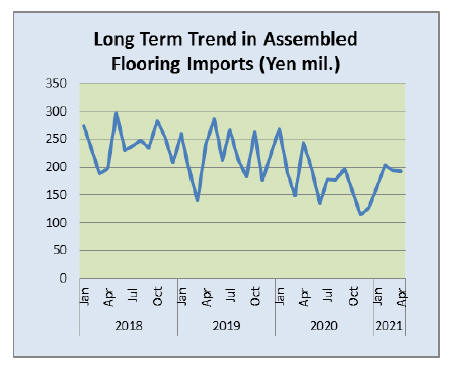
Plywood imports
Year on year the volume of April imports of plywood
(HS441210-39) was down 7% and compared to March the
volume of imports dipped almost 10%, a correction after
the peak in March.
Plywood shipments from Malaysia and Indnesia, the main
suppliers, dropped with shipments from Malaysia showing
a significant deline month on month. In contrast,
shipments from China jumped while the volume of
shipments from Vietnam remained at around the same
level as in March.
Of the various categories of plywood imports, HS441231
accounted for most of April 2021 imports with HS441234,
the second highest category.
 
Trade news from the Japan Lumber Reports (JLR)
The Japan Lumber Reports (JLR), a subscription trade
journal published every two weeks in English, is
generously allowing the ITTO Tropical Timber Market
Report to reproduce news on the Japanese market
precisely as it appears in the JLR.
For the JLR report please see:
https://jfpj.jp/japan_lumber_reports/
2021 National Forest business
The forestry Agency disclosed main subjects of 2021
national Forest business.
Planned sales of logs and timber are 4,882,000 cbms, 6%
more than 2020 but it states that there could be changes
depending on COVID 19 pandemic and supply of
imported wood products.
Business plan based on the budget is 7,163,000 cbms of
main cut (1% more) and 7,064,000 cbms of thinning (2%
more) Sales volume is 2,891,000 cbms of logs (4% more)
and 1,991,000 cbms of timber (9% more) in sales.
System sales are 1,990,000 cbms of logs (3% more)
and
20,000 cbms of timber (67% less). System sales are direct
sales to large consumers like lumber mills and plywood
manufacturers.
In 2020, because of COVID 19 pandemic, supply was
adjusted nationwide so that actual sales decreased from
initial plan on both logs and timber. In 2021, time limit of
harvest and hauling out of timber sold is off and there is
no restriction of timber harvest and extension of public
sales so this year¡¯s result should be higher than last year.
The Forestry Agency says supply and demand of logs vary
by the area so it is necessary to keep watching the situation
closely and exchange information with private timber
owners and forest unions.
Plan of building new logging road is 122 kilometers (15%
less) as the Agency mainly spends budget to maintain
existing logging road system. Planned plantation is 5,400
hectares (14% less) and underbrush cleaning is 22,400
hectares (8% more). 57,400 million yen is allocated to
maintain forests for repair of flood damaged areas.
2020 wood statistics
The Ministry of Agriculture, Forestry and Fisheries
publicized 2020 wood statistics on April 30.
Total demand for logs including imports is 23,550,000
cbms, 10.6% less than 2019. This is the first time that the
volume dropped less than 24,000,000 cbms in ten years.
Domestic logs are 19,882,000 cbms, 9.1% less and
imported logs are 3,668,000 cbms, 17.8% less so domestic
share moved up by 1.3 points to 84.4%.
New housing starts in 2020 are 815,340 units, 9.9% less
than 2019. Increased consumption tax in late 2019 and
COVID 19 outbreak in 2020 are reasons of decline.
Decrease of log demand and drop of housing is almost the
same. Domestic log supply had been climbing from
bottom of 2009 with 16,620,000 cbms for last ten years the turned
downward in eleventh year. Volume of less than
20,000,000 cbms is the lowest in six years since 2014.
Reasons are decrease of logs for lumber by 9.8% from
2019 and logs for plywood also decreased by 11.6%.
By species, cedar decreased by 8.3%, cypress did by 8.9%,
larch did by 9.4% and fir declined by 21.5%.
Imported logs have decreased for four consecutive years
since 2016 and the volume dropped less than 4,000,000
cbms. By source, North American logs dropped down by
17% to 2,840,000 cbms, which takes 77% share in total
imported logs.
Logs from New Zealand decreased by 18.1%. Russian
logs did by 15.9% and South Sea logs did by 37.2%.
Among imported wood products, lumber decreased by
13%, plywood did by 13% and wood chip did by 22%.
Housing starts in 2021 are estimated about the same as
2020 so far but variable factor is supply of imported wood
products, which seem to decrease considerably so demand
shifts to domestic wood. Accordingly domestic log supply
should be up.
South Sea logs
Rainy season is over in the South East Asian countries but
there is not enough foreign workers at logging sites
because of COVID 19 outbreak. Then since last March,
India started buying logs aggressively in Malaysia and
PNG. India had been buying logs from Myanmar but due
to political confusion in Myanmar, India goes to other
supplying countries including Africa.
In Japan, there is not enough reaction to what¡¯s happening
in producing countries with limited demand and ample
inventory now. Prices of South Sea log based Chinese and
Vietnamese products such as laminated free board
continues up because raw materials cost is getting higher.
Anxiety of house builders in ¡°Wood Shock¡±
Nightmarish month of April is over for house builders.
Since late March, supply of wood building materials
became critically short and building materials market got
into real confusion. Housing starts have starter delaying
since May. House builders say this is as bad as natural
disaster and majority comments that housing starts this
year would decrease by 20-30%. Only thing house
builders can do is to secure the imported materials even
with high prices.
House builders could select any precutting plant with
desirable building materials so it has been buyer¡¯s market
all the time for years so some builders are not aware of
change of the situation until last minute while others have
been collecting information through precutting plants and
trading companies and felt the change sooner.
After the largest precutting company has started restricting
taking orders in late March, majority realized seriousness
of the situation and construction has actually started
delaying since May because of shortage of structural
materials and precutting companies started turning down
orders one after another. There are many orders without
any precutting process so these orders are pushed behind
so the situation turned to sellers¡¯ market totally.
Precutting companies are now reviewing relationship with
house builders and select builders with which they can
continue business in fair attitude.
Builders, which have been arrogant, are now dumped so
good past relationship becomes main factor to continue
business. Even local contractors, advanced contractors use
more quality domestic wood so that even when imported
materials are short, they have enough domestic wood
materials so far.
For house builders, sold houses have fixed prices for
house buyers but after they sold, precutting cost jumped
up which builders need to absorb.
Then new orders have no place to precut so
completion
time is pushed forward so builders are not able to tell
house buyers time of completion. Also delay of
construction gives grave impact to builder¡¯s finance.
Sales of detached unit built for sale have been very active
for last one year and the inventory has decreased rapidly
so that builders can sell without any discount but lack of
building materials is the same but builders with sufficient
materials would enjoy good business.
Since COVID 19 pandemic, business of restaurants, bars
and hotels has been badly damaged by the State of
Emergency declaration but housing business in 2020
dropped only by 10% or so which is lucky compared to
other business but now housing market is seriously
damaged by material shortage and the starts this year may
decrease by 20-30%, which is much worse than last year.
This is unexpected incident nobody has experienced
before.
South Sea hardwood plywood market
Market prices of 12 mm panel are climbing. In Tokyo
market, prices of 3x6 coated concrete forming panels are
about 1,430 yen per sheet delivered, 70-80 yen higher than
last month.
Export prices by the suppliers continue climbing and
future prices are as high as 1,500 yen sheet so the dealers
in Japan need to increase the sales prices to catch up future
high prices. Export prices of 12 mm panel have been
climbing by $30 every month since late last year.
General view was that once rainy season is over in March
and April, log supply increases and export prices would be
easing and low cost panel of 1,300 yen contracted in late
last year should arrive so supply shortage would be solved
so the price increase has been small like 20-30 yen at a
time but actually the suppliers in Malaysia like Shing
Yang stopped taking new orders in March to produce
order balance first.
They started taking orders in April but the volume is very
small and the prices are up byUS $30 again so JAS 3x6
coated concrete forming panel prices climbed toUS $650
per cbm C&F. The suppliers do not care about having
future orders unless offered prices are accepted so the
Japanese importers had to accept the offered prices
because the inventory is extremely low in Japan.
Local plywood manufacturers are experiencing labor
shortage because of restriction of moving people across
provinces, which influence logging and plywood mill
operations. Log prices are abnormally high at this time of
year because of aggressive purchase by India. In this
situation, the suppliers ship out mixture of old contracts
and newer high priced contracts so the importers need to
increase the prices much faster now.
Price increase by various manufacturers
Daiken Corporation
Daiken Corporation (Osaka) raised the prices of flooring
with South Sea plywood base. Others are composite floor,
insulation board. MDF manufactured in Malaysia and
New Zealand will be raised by about 15%.
Reasons of price hike are soaring South Sea hardwood
plywood, higher cost of petrochemical products and higher
cost of energy. Prices of composite floor with South Sea
hardwood plywood base and related products are up by
10% and these of composite floor for condominiums with
9 mm base are up by 15%.
Daiken¡¯s total production of floor is about 1.5 million
square meters and products for price hike is 231,000
square meters, only 15% in total floor products.
On MDF, prices of wood chip and adhesive climbed and
transportation cost soared.
Daiken has been shifting to use planted species and
domestic plywood to reduce use of South Sea hardwood
plywood and now 85% of floor is made with such
materials plus MDF, which is named ¡®E hard base¡¯
meaning eco base material. It still uses South Sea
hardwood plywood for high performance floor and sound
proof floor for condos but because of high cost of South
Sea hardwood plywood, it will continue to try using eco
base more.
Nankai Plywood
Nankai Plywood Co., Ltd. (Kagawa prefecture) announced
to increase the prices by 10-20% of all the products with
South Sea hardwood plywood base such as ceiling board,
panel for closet, 12 mm floor and 6 mm floor.
South Sea plywood supply gets tight with log supply
shortage, labor shortage by restriction with COVID 19
outbreak and the prices continue to climb by high price
dealings with busy North American market and container
shortage. Other domestic costs such as adhesive,
cardboard for packaging, trucking and labor continue
escalating.
Asahi Woodtech Corporation
Asahi Woodtech Corporation (Osaka) announced price
hike on products like composite floor since July 1. Items
of price increase are products with South Sea hardwood
plywood and lumber.
Reasons of price increase are sizable increase of South Sea
hardwood plywood and lumber, higher cost of logistics
and other materials. 10-15% price increase is for five
kinds of composite floor, 5-10% up for seven kinds of
composite floor with South Sea hardwood plywood base.
Besides flooring, products with South Sea hardwood
lumber are up by 5-10%.
Eidai
Eidai Co., Ltd. (Osaka) decided to increase the prices of
all the products listed in the catalogue. Price increase of
sound proof floor is about 15%. Other floor prices will be
up by 5-10%.
Solid wood flooring is manufactured in the subsidiary
company in Vietnam. Raw material cost is climbing and
ocean freight is up so price increase is unavoidable. Eidia
has been trying to change floor base from South Sea
plywood to domestic softwood plywood and it targets to
use domestic plywood base up to 50% by 2025.
|